International Journal of Intelligent Systems and Applications @ijisa
Статьи журнала - International Journal of Intelligent Systems and Applications
Все статьи: 1214
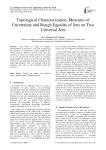
Статья научная
The notion of rough set captures indiscernibility of elements in a set. But, in many real life situations, an information system establishes the relation between different universes. This gave the extension of rough set on single universal set to rough set on two universal sets. In this paper, we introduce rough equality of sets on two universal sets and rough inclusion of sets employing the notion of the lower and upper approximation. Also, we establish some basic properties that refer to our knowledge about the universes.
Бесплатно
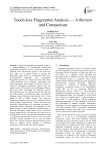
Touch-less Fingerprint Analysis — A Review and Comparison
Статья научная
Touch-less fingerprint recognition system is a reliable alternative to conventional touch-based fingerprint recognition system. Touch-less system is different from conventional system in the sense that they make use of digital camera to acquire the fingerprint image where as conventional system uses live-acquisition techniques. The conventional fingerprint systems are simple but they suffer from various problems such as hygienic, maintenance and latent fingerprints. In this paper we present a review of touch-less fingerprint recognition systems that use digital camera. We present some challenging problems that occur while developing the touch-less system. These problems are low contrast between the ridge and the valley pattern on fingerprint image, non-uniform lighting, motion blurriness and defocus, due to less depth of field of digital camera. The touch-less fingerprint recognition system can be divided into three main modules: preprocessing, feature extraction and matching. Preprocessing is an important step prior to fingerprint feature extraction and matching. In this paper we put our more emphasis on preprocessing so that the drawbacks stated earlier can be removed. Further preprocessing is divided into four parts: first is normalization, second is fingerprint Segmentation, third is fingerprint enhancement and last is the core point detection. Feature extraction can be done by Gabor filter or by minutia extraction and the matching can be done by Support Vector Machine or Principal Component Analysis and three distance method.
Бесплатно
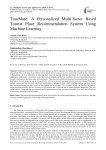
Статья научная
Building a personalized travel recommendation system is important to enhance the satisfaction and experience of travelers. Due to the lack of an efficient online-based tourist assistance system, tourists have faced several challenges in Bangladesh, such as difficulties in planning their trips and making informed decisions. To overcome the existing challenges, in this paper, a prediction model has been developed to predict the suitability of a travel destination based on the user’s preferences and some other relevant factors. Then the system offers personalized recommendations for the best local places to visit, hotels to stay in, transportation services, and travel agencies with the necessary details. This paper utilizes various machine learning classification algorithms to predict the best-suited travel destinations and local tourist spot recommendations for users based on their budget and preferences. The examined results verified that the random forest algorithm provides the best accuracy of 98 percent and is used for tourist place eligibility prediction. The user rating analysis visualized that the proposed mobile application received satisfactory remarks from more than 60 percent of reviewers regarding its effectiveness.
Бесплатно
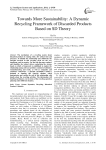
Towards More Sustainability: A Dynamic Recycling Framework of Discarded Products Based on SD Theory
Статья научная
The mechanism of a recycling system about discarded products is running with a few critical roles and processes. To identify the relationship and collaborate the activities involved in this recycling circle are the very significant work in practice. For the sake the paper explores and identifies the critical drivers underlying the system, based on which a framework is established to explore the relationship among relevant activities consisted of collection, remanufacturing and resale, as well as companies and customers’ behaviours. A dynamic quantitative model is designed to simulate this vigorous relation, which demonstrates and verifies the rule of this relationship with details about the recycling activities. The information will benefit practitioners a lot in terms of the recycling operation planning under different situation.
Бесплатно
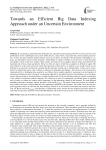
Towards an Efficient Big Data Indexing Approach under an Uncertain Environment
Статья научная
It is generally accepted that data production has experienced spectacular growth for several years due to the proliferation of new technologies such as new mobile devices, smart meters, social networks, cloud computing and sensors. In fact, this data explosion should continue and even accelerate. To find all of the documents responding to a request, any information search system develops a methodology to confirm whether or not the terms of each document correspond to those of the user's request. Most systems are based on the assumption that the terms extracted from the documents have been certain and precise. However, there are data in which this assumption is difficult to apply. The main objective of the work carried out within the framework of this article is to propose a new model of data service indexing in an uncertain environment, meaning that the data they contain can be untrustworthy, or they can be contradictory to another data source, due to failure in collection or integration mechanisms. The solution we have proposed is characterized by its Intelligent side ensured by an efficient fuzzy module capable of reasoning in an environment of uncertain and imprecise data. Concretely, our proposed approach is articulated around two main phases: (i) a first phase ensures the processing of uncertain data in a textual document and, (ii) the second phase makes it possible to determine a new method of uncertain syntactic indexing. We carried out a series of experiments, on different bases of standard tests, in order to evaluate our solution while comparing it to the approaches studied in the literature. We used different standard performance measures, namely precision, recall and F_measure. The results found showed that our solution is more efficient and more efficient than the main approaches proposed in the literature. The results show that the proposed approach realizes an efficient Big Data indexing solution in an Uncertain Environment that increases the Precision, the Recall and the F_measure measurements. Experimental results present that the proposed uncertain model obtained the best precision accuracy 0.395 with KDD database and the best recall accuracy 0.254 with the same database.
Бесплатно
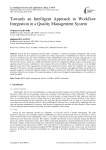
Towards an Intelligent Approach to Workflow Integration in a Quality Management System
Статья научная
Among the most important activities within a company we find that of quality management. This activity represents reflects the most rigorous way possible for a better organization of establishments in order to offer the best service to customers and to the various members of these establishments. This activity of quality management is a very delicate and sensitive task due to the large number of documents and business processes that are handled on a cyclical basis. For this reason, setting up a reliable and efficient system for managing the different aspects of the quality management process becomes a challenge for any company that seeks excellence. This article proposes a new intelligent approach to the need of the management of human and commercial resources within the companies for a good management of the process of quality management according to its own conception. Our approach allows any quality management manager to manage the different modules of a QMS according to the ISO 9001 standard through the different interfaces offered by our solution. The monitoring phase of this process through the implementation of a workflow orchestrator, jBpm.
Бесплатно
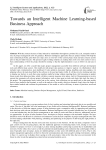
Towards an Intelligent Machine Learning-based Business Approach
Статья научная
With the constant increase of data induced by stakeholders throughout a product life cycle, companies tend to rely on project management tools for guidance. Business intelligence approaches that are project-oriented will help the team communicate better, plan their next steps, have an overview of the current project state and take concrete actions prior to the provided forecasts. The spread of agile working mindsets are making these tools even more useful. It sets a basic understanding of how the project should be running so that the implementation is easy to follow on and easy to use. In this paper, we offer a model that makes project management accessible from different software development tools and different data sources. Our model provide project data analysis to improve aspects: (i) collaboration which includes team communication, team dashboard. It also optimizes document sharing, deadlines and status updates. (ii) planning: allows the tasks described by the software to be used and made visible. It will also involve tracking task time to display any barriers to work that some members might be facing without reporting them. (iii) forecasting to predict future results from behavioral data, which will allow concrete measures to be taken. And (iv) Documentation to involve reports that summarize all relevant project information, such as time spent on tasks and charts that study the status of the project. The experimental study carried out on the various data collections on our model and on the main models that we have studied in the literature, as well as the analysis of the results, which we obtained, clearly show the limits of these studied models and confirms the performance of our model as well as efficiency in terms of precision, recall and robustness.
Бесплатно
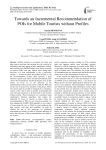
Towards an incremental recommendation of POIs for mobile tourists without profiles
Статья научная
Mobile tourism or m-tourism can assist and help tourists anywhere and anytime face the overload of information that may appear in their smartphones. Indeed, these mobile users find difficulties in the choice of points of interest (POIs) that may interest them during their discovery of a new environment (a city, a university campus ...). In order to reduce the number of POIs to visit, the recommendation systems (RS) represent a good solution to guide each tourist towards personalized paths close to his instantaneous location during his visit. In this article, we focus on (1) the detection of the spatiotemporal context of the tourist to filter the POIs and (2) the use of the previous notations of the places. These two criteria make it possible to integrate the evolutionary context of the visit in order to predict incrementally the most relevant transitions to be borrowed by the tourists without profile. These predictions are calculated using collaborative filtering algorithms that require the collection of traces of tourists to better refine the recommendation of POIs. In our software prototype, we have adapted the SLOPE ONE algorithm to our context of discovering the city of Chlef to avoid problems like data scarcity, cold start and scalability. In order to validate the use of this prototype, we conducted experiments by tourists in order to calculate indicators to assess the relevance of the recommendations provided by our system.
Бесплатно
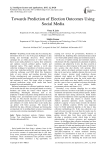
Towards prediction of election outcomes using social media
Статья научная
Exploiting social media data by extracting key information from it is one of the great challenges in data mining and knowledge discovery. Every election campaign has an online presence of voters which uses these social media platform to express their sentiments and opinions towards political parties, leaders and important topics. This paper presents a novel data collection technique for prediction of election outcomes and a topic modeling method for extracting topics. Data collection technique used RSS (Rich Site Summary) feeds of news articles and trending keywords from Twitter simultaneously and constructed an intelligent prediction model based primarily on the volume of tweets and sentiment of users. This paper effort to improve electoral predictions using social media data based dynamic keyword methodology. Different techniques for electoral prediction based on social media data has been investigated based on existing literature and isolate the factors which improve our methodology. Meaningful inferences such as the popularity of leaders and parties during different intervals, trending issues, and important factors are extracted from the data set. The election outcomes are compared with traditional methods used by survey agencies for exit polls and validation of results showed that social media data can predict with better accuracy. The research has identified that data collection technique and timing play an important role in yielding better accuracy in predicting outcomes and extracting meaningful inferences.
Бесплатно
Track Processing Approach for Bearing-Only Target Tracking
Статья научная
This paper mainly studies angle-measurement based track processing approach to overcome the existing problems in the applications of traditional approaches for bearing-only target locating and tracking system. First, this paper gives suited data association algorithms including track initiation and point-track association. Moreover, a new tracking filtering association gate method is presented through analysis of the target motion characteristics in polar coordinates for improving bearing-only measurement confirming efficiency of real target and limiting false track overextension with the dense clutter. Then, by analyzing the feasibility of using multi-model technology, the IMM is adopt as filtering algorithm to solve existing problem in bearing-only tracking for complicated target motion in two dimensional angle plane. As the results, the two dimensional bearing-only tracking accuracy of real target is improved and false tracking is greatly limited. Moreover, computation cost of IMM is analyzed in view of the real-time demand of bearing-only tracking. Finally, this paper gives some concrete summary of multi-model choosing principle. The application of the proposed approach in a simulation system proves its effectiveness and practicability.
Бесплатно
Tracking Power Photovoltaic System using Artificial Neural Network Control Strategy
Статья научная
Photovoltaic generation is the technique which uses photovoltaic cell to convert solar energy to electric energy. Nowadays, PV generation is developing increasingly fast as a renewable energy source. However, the disadvantage is that PV generation is intermittent because it depends considerably on weather conditions. This paper proposes an intelligent control method for the maximum power point tracking (MPPT) of a photovoltaic system under variable temperature and solar irradiation conditions. In this paper, a simulation study of the maximum power point tracking (MPPT) for a photovoltaic system using an artificial neural network is presented. The system simulation is elaborated by combining the models established of solar PV module and a DC/DC Boost converter. Finally performance comparison between artificial neural network controller and Perturb and Observe method has been carried out which has shown the effectiveness of artificial neural networks controller to draw much energy and fast response against change in working conditions.
Бесплатно
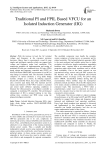
Traditional PI and FPIL based VFCU for an isolated induction generator (IIG)
Статья научная
With the increase in load, the AC terminal voltage and frequency at the consumer premises decreases. Hence, there is encountered a need of some simple and intelligent controller which can support both voltage and frequency under load conditions. This manuscript emphasis on implementation and testing of traditional PI and non- traditional fuzzy PI logic (FPIL) based voltage and frequency controller unit (VFCU) in MATLAB based SIMULINK environment for an IIG for step change in consumer load. The electronic Controller comprises of various elements: a 3-leg diode bridge rectifier, chopper as a switch, dc filtering capacitor, discrete PI controller block, fuzzy logic controller block, and a resistive type dump load. The transient and the steady state behavior of IIG-VFCU system is examined and tested under different operating conditions to illustrate the efficaciousness of intelligent controller as compared to traditional PI controller. The performance enhancement of IIG is attained relating to rise time, settling time, overshoot and THD values using the planned intelligent controller.
Бесплатно
Trajectory Tracking of Linear Inverted Pendulum Using Integral Sliding Mode Control
Статья научная
This paper considers the trajectory tracking control of linear inverted pendulum (IP) system. First the linearized model of IP is derived to facilitate the control design. To avoid non robust reaching phase, integral sliding mode control (ISMC) has been proposed but single variable case is tested. Linear IP is a multivariable system having angle of pendulum and position of cart are two variables to be controlled. In control design, the LQR control is designed as a nominal control to get the desired trajectory. Then discontinuous control using integral sliding mode(ISM) is introduced to get desired trajectory tracking in the presence of uncertainties. This control is robust to the model uncertainties and disturbances during entire motion of the states. The simulation results are presented to show the effectiveness of proposed control scheme. The results are compared with LQR control to show the integral sliding mode control is having better tracking performance in the presence of uncertainties.
Бесплатно
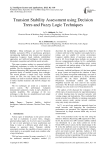
Transient Stability Assessment using Decision Trees and Fuzzy Logic Techniques
Статья научная
Many techniques are used for Transient Stability assessment (TSA) of synchronous generators encompassing traditional time domain state numerical integration, Lyapunov based methods, probabilistic approaches and Artificial Intelligence (AI) techniques like pattern recognition and artificial neural networks. This paper examines another two proposed artificial intelligence techniques to tackle the transient stability problem. The first technique is based on the Inductive Inference Reasoning (IIR) approach which belongs to a particular family of machine learning from examples. The second presents a simple fuzzy logic classifier system for TSA. Not only steady state but transient attributes are used for transient stability estimation so as to reflect machine dynamics and network changes due to faults. The two techniques are tested on a standard test power system. The performance evaluation demonstrated satisfactory results in early detection of machine instability. The advantage of the two techniques is that they are straightforward and simple for on-line implementation.
Бесплатно
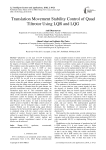
Translation movement stability control of quad tiltrotor using LQR and LQG
Статья научная
Quadrotor as one type of UAV (Unmanned Aerial Vehicle) is a system that underactuated. It means that the system has a signal control amount is lower than the degrees of freedom or DOF (Degree Of Freedom). This condition causes the quadrotor have limited mobility. If quadrotor is made to have 6 DOF or more (overactuated system), the motion control system to optimise the flight will be different from before. We need to develop overactuated quadrotor control. Quadtiltrotor as the development of quadrotor has some control signal over its DOF. So we call it as an overactuated system. Based on the type of manoeuvre to do, the transition process when the quad tiltrotor performs a translational motion using the tilting rotor need special treatment. The tilt angle change is intended that the quad tiltrotor can perform translational motion while still maintaining its orientation angle near 0°. This orientation angle can change during the undesirable rotational movement as the effect of the transition process. If additional rotational movements cannot be damped, the quad tiltrotor can experience multi overshoot, steady-state error, or even fall. Because of this matter, we need to develop flight control system to handle it. The flight control system of quad tiltrotor can be designed using a model of the system. Models can be created using quad tiltrotor dynamics by the Newton-Euler approach. Then the model is simulated along with the control system using the method of control. Several control methods can be utilised in a quad tiltrotor flight systems. However, with the implementation of LQG control method and Integrator, optimal translational control of the quad tiltrotor can be achieved.
Бесплатно
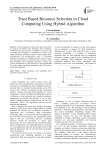
Trust Based Resource Selection in Cloud Computing Using Hybrid Algorithm
Статья научная
Cloud computing is experiencing rapid advancement in academia and industry. This technology offers distributed, virtualized and elastic resources as utilities for end users and can support full recognition of “computing as a utility” in the future. Scheduling distributes resources among parties which simultaneously and asynchronously seek it. Scheduling algorithms are meant for scheduling and they reduce resource starvation ensuring fairness among those using resources. Most Task-scheduling cloud computing procedures consider task resource requirements for CPU and memory, and not bandwidth. This study suggests optimizing scheduling with BAT-Harmony search hybrid algorithm.
Бесплатно
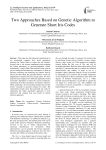
Two Approaches Based on Genetic Algorithm to Generate Short Iris Codes
Статья научная
This paper has the following contributions in iris recognition compass: first, novel parameters selection for Gabor filters to extract the iris features. Second, due to iris textures randomness and assigning the Gabor parameters by pre-knowledgeable values, traditionally, a large Gabor filter bank has been used to prevent losing the discriminative information. It leads to perform extracting and matching the features heavily and on the other hand, the generated feature vectors are lengthened as required for extra storage space. We have proposed and compared two different approaches based on Genetic Algorithm to reduce the system complexity: optimizing the Gabor parameters and feature selection. Third, proposing a novel encoding strategy based on the texture variations to generate compact iris codes. The experimental results show that generated iris codes by optimizing the Gabor parameters approach is more distinctive and compact than ones based on feature selection approach.
Бесплатно
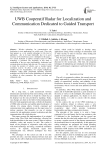
UWB Cooperatif Radar for Localization and Communication Dedicated to Guided Transport
Статья научная
Wireless technology for communication and localization in train applications are widely used. Ultra wide band appears as a very suitable technology for this kind of application, due to its large bandwidth, also to its good resistance to the interference and to multipath. In this paper, a new system dedicated to railway transport, based on UWB technology is presented. The originality of this study is combination of the two main functionalities, localization and communication providing a high data rate. The sensor, in order to detect the position of vehicles, uses a matched digital correlation receiver. To allow a multi user access and to combine the two functionalities, two original multiplexing techniques called SSS2 (Sequential Spreading Spectrum technique) and CPM (Code Position Modulation) are performed, in addition to other parameters like used waveform and orthogonal codes.
Бесплатно
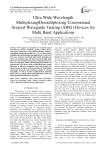
Статья научная
This paper has proposed new materials based conventional arrayed waveguide grating (AWG) devices such as pure silica glass (SiO2), Lithium niobate (LiNbO3) , and gallium aluminum arsenide (Ga(1-x)Al(x)As) materials for multiplexing and demultiplexing applications in interval of 1.45 μm to 1.65 μm wavelength band, which including the short, conventional, long, and ultra long wavelength band. Moreover we have taken into account a comparison between these new materials within operating design parameters of conventional AWG devices such as diffraction order, length difference of adjacent waveguides, focal path length, free spectral range or region, maximum number of input/output wavelength channels, and maximum number of arrayed waveguides. As well as we have employed these materials based AWG to include Multi band applications under the effect of ambient temperature variations.
Бесплатно
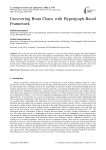
Uncovering Brain Chaos with Hypergraph-Based Framework
Статья научная
The scientist has proven that the birth of neurons in a region of adult rat brain migrates from their birthplace to other parts of the brain. The same process also happens in adult humans. There was no efficient visualization tool to view the functions and structures of the human brain. In this paper, we focus to design a framework to understand more about Alzheimer’s disease and its process of neurons in the human brain. This framework named a hypergraph-based neuron reconstruction framework. It helped to map, the birth and death of neurons with the construction and reconstruction of the hypergraph. This framework also recognizes the structural changes during the life cycle of the neuron. Its performance was evaluated quantitatively with small-world networks and robust connectivity measures.
Бесплатно

